Tag Archives: Naming
How to Match Your New Brand Name with an Appropriate Domain Name
Naming your brand successfully (see our White Paper on this topic) and formulating your domain name go hand in hand. Every startup has different needs when it comes to domain ownership. Is owning your .com domain outright the only way to go? Or are there other ways you can have success with a creatively modified domain? Even if you have already answered these questions, factors such as domain availability, pricing, and trademark rights will all influence your final decision. In this white paper we offer a personalized guide to help you make strategic and informed decisions as you go through the process of choosing your new domain name.
Download our free white paper to learn about:
- Branding your domain name
- The process of choosing a domain
- Purchasing a domain from an existing owner
- What to do when the .com domain name for your brand is unavailable
- How much money is a .com domain worth?
- Alternatives to “brand.com” ownership
Simply enter your email address to download.
We will use the information you provide on this form to send you insights and, at times, marketing emails about our services. You can unsubscribe at any time through a link in the footer of any email from us. For more information, please read our Privacy Policy located at the bottom of this page.
CATEGORIES: White Papers
Why We Should Not Ridicule Re-Branding Exercises, Yet Why Tronc Deserved It
Naming a company, any company, is not an easy task.
Branding is the first thing your audience will be exposed to, that is especially true when it comes to the name. A name you can’t re-launch like a campaign, a site or even periodically a logo. You better not change it at all. It’s like with your child; you can advise on clothes and friend choices as they hit puberty, but that name you gave them, that will stick forever. So yes, it’s very, very darn important.
Late last week I was contacted by LAist about the (by now infamous) name Tribune Publishing gave itself in a (presumably) hasty re-branding exercise, given they were in a legal battle. Below is what I shared with the reporter, and now with you:
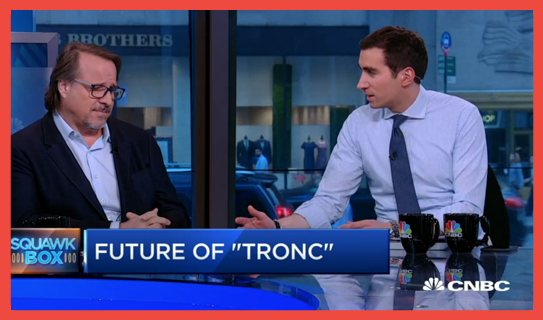
When else have you seen a major company’s name in quotation marks? (Picture via CNBC)
Here are some of the many rules I apply when crafting a company name and here is how our new f(r)iend tronc measures up:
#1 Short and easy to pronounce, easy to spell
Got that one right…yet many will misspell it as ‘tronk’ based on ‘trunk.’
#2 Available .com
I hope that’s not the look of a large publishing group, so they might still be in talks to purchase the domain. Oh, wait, it actually is the real tronc. Maybe we should move the conversation over to talk about the logo at this point? Makes me wonder, does this site work in Netscape?
#3 Passes the Google test
They got enough press very quickly that they dominate the first page on Google. If we do an image search we can not see the tronc for the tree trunks though.
#4 Tells a story
You tell me! OK, “Tribune Online Content” does not qualify as a story.
#5 Stands out (but not too far) from competitors
Surely stands out, but quite sure that it’s way too far.
Given that this re-brand came out of a lawsuit, this name is the result of a lean startup-style ‘speed-to-market’ naming exercise. As with most startups, this rush shows and backfires quickly. Sadly, a respectable company that needed to move away from its naming issues and signify very different benefits and changes to its audience, instead hit branding rock bottom.
It is of course very easy to jump on the re-branding trash talk wagon quickly, despite it never being fair not having been part of the process and understanding all the underlying reasons and restrictions. With endless trunk, junk, Tron and Trump jokes on the way, it does feel like this will be a trunk show that won’t be too exclusive, nor end anytime soon. This one surely is justified and I am whole-heartedly riding on that brand trash talk train (as it is indeed kinda fun).
Find them on Nasdaq starting 06/20 under the ticker TRNC – might as well have called it that; would have resonated with the same audience that would ‘dig’ tronc. And that audience ain’t theirs.
CATEGORIES: Blog Startup Advice Your Brand Launch: Naming
Coin It: 3 Reasons Why Your Venture Needs To Develop Nomenclature
Getting a venture off the ground is tough. Competing against similar startups and established players along the way is even tougher.
One tool to add to your ‘brand insurance box’ (you know, the things you do that make your venture a strong brand) is also one of the simplest and most valuable branding efforts you can undertake: creating a term you can own.
Below I outline 3 reasons why owning your language will leave a quantifiable mark on your brand:
1. It Differentiates You From Your Competitors
Don’t come up with a term for branding’s sake, rather evolve it naturally. The last thing you want to do is to confuse your customer with strange lingo, instead you want to inform and educate. Think of industry terms that are being used within your segment by your customers – are they all clearly saying what you’d want them to say, or are some misguiding, perhaps even outdated based on the solution your venture offers? Some you might flat-out hate or poke fun at regularly for good reason.
I, for instance, hated the term ‘brand collateral’ to describe the pieces a brand uses to communicate its brand values, visuals and language to clients, consumers and prospects. During the process of writing the book ‘How to Launch a Brand,’ I demanded a better term for the visual and verbal brand communication pieces and I coined the term ‘Brand Atmospheres.’ To me it made for a much stronger and all-encompassing description that felt logical rather than confusing. I trademarked the term, linked it to our web site, named one of four chapters in the book after it and soon prospects started talking about how ‘they needed to revisit their Brand Atmospheres.’ Long gone were brand collateral conversations.

It’s not on the scale of someone asking for a Kleenex or making a Xerox of a document, but within my niche it made me realize just how much of a differentiator it became to have marked a term that is being used in conversations by prospect clients. It strengthens the brand perception and creates an immediate relationship between prospect and provider.
2. It Establishes Immediate Trust
Maybe you have a process, a specific way of doing things? Will you call it ‘Our unique process’ or will you actually give it a unique name that describes your thinking in a better way? I named our one day brand strategy workshop for startups ‘Resonaid,’ to further describe the function of the workshop: It serves as an aid to make your brand resonate with its customer from the get-go. It turned our process into a product that is instantly tangible as well as ownable.
The unique thing you do, whatever it may be, give it a unique name. If it’s unique it deserves it; perhaps even demands it.
People trust something you truly own (up to). It not only adds importance, it also makes it unique to you, which relates to your offering as being substantial, or substantially better than the one of your competitors. Most founders start at the brand name and end at the product name missing out on all the terms in between, which establish trust along the way of the decision making process.
3. It Creates Intrigue And Belonging
Creating a lingo is like your own secret language, which won’t remain a mystery for long. It’s like writing with invisible ink, only that everyone will ask you to see it. Everyone will want to be ‘in the know’ and once they are, they will be darn proud of it. They have a sense of belonging. They don’t grab donuts at Strange Donuts in St. Louis, no, they grab dones. They call me and ask for a Resonaid workshop, not about the ‘brand creation’ workshop.
Adding intrigue to a brand is every marketers goal. Usually that involves big campaigns on even bigger budgets. By adding unique nomenclature to your branding efforts, you hit that intrigue mark on a much tighter budget.
While other startups try to become ‘the Uber of their industry’ why don’t you take the direction of becoming ‘the Kleenex of your industry’ instead? They will call you by your name. Promised.
How to Trust Your Decisions as a Startup Founder
This post has not much to do with branding, but it is a topic that I know a lot of startup founders are secretly struggling with, regardless of age, and it puts a huge bump into their road to success. Let’s change that.
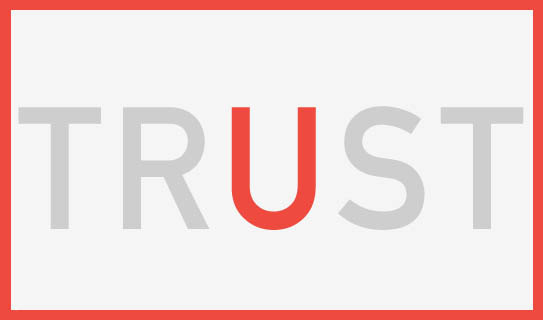
I run a brand consultancy that advises new ventures on a distinct and definite brand direction to take. We name new ventures – from any vertical – that don’t have a single customer yet. We create a fictitious target audience and we craft a name to work for them. A name that will soon be used by thousands of actual customers worldwide. We do not use focus groups, instead we base the direction on brand strategy and insights we craft and collect during the process. If the name works within our criteria we go for it and there is no turning back. Referencing Henry Ford’s famous quote – “If I had asked people what they wanted, they would have said faster horses” – most focus groups will pick the safe option, the option that feels most familiar, an option that may not look into the future enough to have the biggest impact (For more on that, see my thoughts on TopGolf).
The minute I let go of questioning my decision, of needing proof of concept, bigger and more innovative ideas keep emerging and my clients get just as energized as myself by the opportunity to do big thinking that will immediately be implemented into their brand strategy and subsequent launch. It’s the magic moment where creativity gets delivered with confidence and is met by trust.
With experience sure comes confidence, but also with writing regularly. I learned that the more I write (for this blog, but also for Inc, Entrepreneur and others) on my subject expertise, the more it forces me to analyze my daily observations. I translate them into a firm opinion that I can send to an editorial team, knowing that thousands of people of all levels of expertise (like yourself) will soon read it and I can not have any regrets. There is no looking back. In the beginning I was literally refreshing the comments field every minute to wait for the big backlash to happen, but then I realized it does not work that way.
All it takes is trust in yourself and trust in your decisions. That trust is crucial to anyone, but for founders it is of higher importance as it directly affects the success not only of themselves, but of their startup.
As a startup founder you have to be the ultimate leader: You lead your co-founders to believe in your vision, the product, and in yourself. Then you lead investors to put money into an intangible idea, but really they too are investing in you.
Your startup, in the end, is built more on you trusting your own decisions, and conveying that to everyone around you, than it is on your idea or your product. Definitely not the added features that you spent weeks perfecting. Scrap that. Instead, perfect the most important asset of this startup: Yourself.
Start by doing this: Next time you contemplate, you take a lot of time to form an opinion, you ask everyone for their thoughts, you start to implement tests to gain big data…Stop! Step back, make a firm decision, deliver it with confidence and move on. Big things will happen.
Trust me.
CATEGORIES: Blog Startup Advice Your Brand Launch: Naming
Naming Your Company? 4 Ways to Get Unbiased Feedback
Sell your team on a new company name by following these four steps.
This article was originally published on Inc on June 10, 2015.
Two years ago, I had an epiphany. And I did what entrepreneurs fear most after successfully being in the same business for over a decade: I made a big change. I decided to drastically reposition my design and branding business, and with that came the necessary name change.
After crafting hundreds of names, I picked the name FINIEN. The team had its doubts. The name could be reminiscent of a shark (fin) or even death (finir in French = to finish), hence no one would ever hire us again, especially as a consultancy that crafts names for a living. We might be doomed. Despite these fears, we moved forward with the name, and that decision has treated us well.
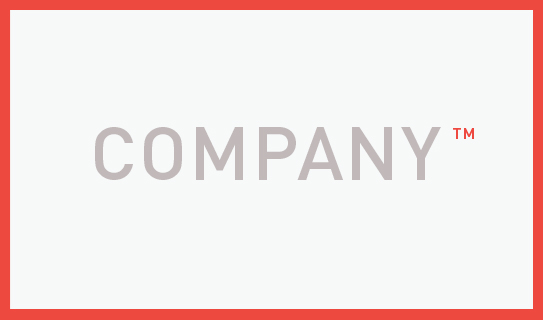
Here are four key takeaways from naming companies like our own that will assist on your quest for a great company or product name. The rule above all rules: after consulting with (and hiring) professionals who derive names for a living, trust your gut and go for it.
So you went through the checklist and you feel it is the right name for your company moving forward. If that’s the case, don’t open it up for the emotional, unproductive feedback typical of a larger group. If you ask your significant other, (s)he will likely react emotionally and might not understand the full strategy, research and context. (S)he will hear an unfamiliar name and will immediately sense danger. If you ask your co-workers, they might have similar feelings, in addition to the fear of their professional future within your company. What if the name backfires? Why does our fearless leader have to ask us, “Is it not a good name?”
They should be afraid. Naming is a scary thing, but lucky for them, you already did that part for them and you’re confident that you’re on the right path. That said, sometimes you just have to ask for peace of mind and to give your key partners a feeling of ownership prior to officially taking this significant step.
As long as you present a clear case as to why a name change is necessary, tell them that you’ve narrowed it down to 1 (or 2) final name(s) through hiring a professional naming agency (if applicable) and that you have a clear favorite (and explain why). You now want their buy-in (what you will get is their opinion) just in case you forgot anything when making that decision (and make sure they’re in the know for the big announcement). If you’re about to have that meeting, here’s how to go about it the right way:
1. Define the Confidants. They Will Define The Outcome.
Who should be the two to four people who you want to gain feedback or buy-in from? Choose them based on their involvement in your company. They may be co-founders or partners, but they shouldn’t be freelancers, non-VC level employees or peers. Not to discriminate, but to keep it to a very small and influential group that you’d like to have your back during the rollout phase.
2. Be Confident. Be Assuring.
Tell them you made up your mind, even if you’re still split between two names. Explain why the change was necessary. Share how long the process took and how many names you went through to get there. If applicable, share that they’ve been professionally derived and vetted and you feel very excited about the new company/product name. It’s a new era and you’re thrilled to let them in early on.
3. Story First. Names Later.
Present them with only one or two names. Even if you’re still indecisive, sound assertive. If your presentation feels insecurely, they will feed that fire. First, tell the story of each name as well as the meaning and the keywords that have been used–only then show them the name. After sharing the backstory, say the name out loud while showing it on screen or on paper. As they familiarize themselves with the name, tell them your grand vision for how clients and co-workers will use it, how it sounds answering the phone, how great it would look visually, and how the name really tells the story of your company without limiting your future growth. Repeat for name No. 2, all while keeping the next rule in mind.
4. Leave the Past Behind: Say Hello To the Future
While looking at the new naming options, most will only associate with the past (the ‘faster horses’ syndrome). You’ll have to reiterate the idea that this new word will soon not represent any current connotations (usually only negative ones will be brought up by the group, like ‘death’ and ‘shark’), but will instead represent your company. Your mindset is already in the future; if you’re renaming, you already emotionally detached from the current and attached to the new name. It will be a big challenge for them to overcome. Remember our name, FINIEN? The (short and rather brilliant) name would have likely died by committee based on past associations. Today, you hear FINIEN and you think about branding, startups, and yours truly. It’s how it works. Brands are being built. You have to explain why it’s necessary to think of the name six months from today. Try not to associate any words with the name, but rather the image of your company.
Gaining buy-in is crucial to finding a great name. Use these points to prep for the meeting that may decide the future of your brand’s name. And, most importantly, trust your gut.
CATEGORIES: Startup Advice Your Brand Launch: Naming
5 Ways To Create A Timeless Brand
Creator, the beautiful online magazine of wework, the highly inspirational community of creators, published an original article by yours truly yesterday, so I thought sharing is caring. It goes something like this:
If I say “Coca-Cola,” you probably see the cursive typeface, red and white colors, curved bottles, and polar bears, right? That’s because Coca-Cola has spent decades building its brand with precise imagery, a consistent logo, and steadfast messaging.
While Coca-Cola is the quintessential timeless brand, many entrepreneurs have a tough time replicating its success because they’re drawn to the latest fads. Unfortunately, that’s not the key ingredient for enduring the test of time.

Photo credit: Lauren Kallen (Via Creator)
Styles change, but your company’s name and logo should not. You need to get it right from the beginning so you won’t confuse your target audience. It’s imperative that you create a brand that reflects your company’s values and is based on a shared passion with your target audience.
The brand that stays top of mind with consumers is the one that was built with “soul,” is driven by passion, and is marketed truthfully and consistently. A brand like Coca-Cola is truly timeless. Despite shifting marketing and advertising efforts, the brand is always surrounded by its unmistakable logotype and color scheme.
So how do you build a timeless brand? Here are five tips to get started:
- Buck the trends. If it’s in the moment, it’s unlikely to be in the future. Trends don’t hold up over time. People want something that stands out. A trend is cool for a very short time, then it quickly turns into an annoyance. The more honest and creative you are when crafting your brand identity, the more likely it is that you’ll create something timeless.
- Find a unique angle. If you try too hard to be like everyone else, you won’t be able to define your own unique brand identity. Look beyond your competitors, and dive deep into your own beliefs. Nail down what you’re about as a company, basing it on your core values, then determine how you want to communicate that to your target audience. Once you decide exactly what message you want to get across to your audience, you can create a truly unique visual and verbal brand language that’s lasting.
- Define your brand. A timeless brand has a shared passion with its audience. For example, Patagonia makes clothing for people who love climbing, skiing, and other outdoor sports that don’t require a motor. The brand caters to anyone who likes to connect with nature—hence it was able to expand from climbing gear to items for all other outdoor activities without losing its focus. This shared passion is directly reflected in the company’s sales because saving Mother Nature equals saving its audience’s playground.
- Be consistent. Your company name and logo are the first things that people will think about when your brand comes to mind, so keep them consistent. Make sure your logo is distinct, easy to adapt across different media types, and reflective of what your product or service actually delivers. (Hint: As you can learn from Zappos, it’s happiness, not shoes.)
- Avoid being too descriptive. When launching your brand, stay away from a name or logo design that’s too descriptive to avoid costly rebranding as your core focus shifts in the future. The uncertainty surrounding a rebranding effort could cost you time, money, and even loyal customers. At the very least, you’ll confuse them—as we recently saw with Airbnb’s rebrand PR nightmare.
When you solidify your brand from the start, you can focus on stabilizing it and investing in it. A brand that’s in unison with its identity remains relevant over time, and every party involved knows why the brand looks, walks, and talks a certain way. Base your brand on your unique offering, and connect with your audience meaningfully—you’ll be well on your way to developing a timeless brand.
Twitter’s Periscope: What’s The Naming Scope
As you may have heard, Meerkat now has a new, serious, competitor. And no, it’s not the Minneapolis agency Periscope, which greatly enjoyed getting a lot of buzz today when Twitter launched Periscope.
Twitter did not talk to the agency by the same name, has not asked them for their Twitter handle @periscope (Wait, really? They kept @periscopeco), nor cared about the fact that they are naming their product the same way. Twitter decided to stick with the name of the startup they acquired, a very ‘speed-to-market’ move, and when it comes to naming, a highly questionable one.
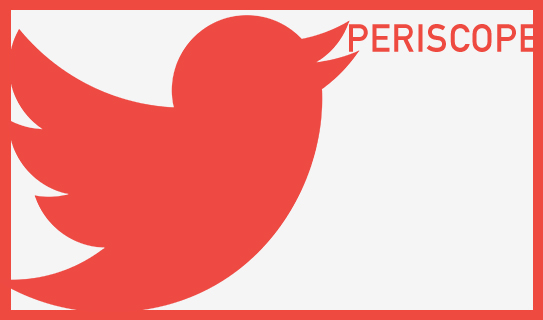
Twitter is 36.5 million followers larger than the agency by the same name, and the world will, after just a few days, think of Twitter’s service – and Twitter’s service alone – when hearing the name Periscope. Periscope, the agency, will not be so happy about it when confusion turns into annoyance and a dillusion of their smart brand name.
The question remains: Why stick with the name Periscope? A rather great name for a ‘full-spectrum creative agency’ that helps uncover and look at things differently, but for a live-streaming app?
Given all the red flags, they kept going with a name that stands for an apparatus consisting of a tube attached to a set of mirrors or prisms, by which an observer (typically in a submerged submarine or behind a high obstacle) can see things that are otherwise out of sight (via Google).
Leaving early adopters to adjust to a new name in order for a brand to focus on its much bigger future after having serious funding infused, or being bought by the big guys, would be the right move. Startup names are often just that, they are quick MVP’s of something that really should not be driven by lean startup methodology to start with. And definitely not go past an acquisition or merger.
CATEGORIES: Startup Advice Your Brand Launch: Naming
“You Told Me My Company Name Sucks”
…was the subject line of an E-Mail I received a few days ago. Needless to say, I was intrigued to read on:
“I called my company “(Name Withheld)”, but you told me it was horrible. For that reason I wanted to reach out and say THANK YOU!”
He listened and he turned the page and now he is grateful for my frank advice just as much as for him listening and acting upon it. This is how I want to start off the New Brand Post for 2015 as it sums up what is key to branding a new venture, and what I want you to keep upfront and center this year.
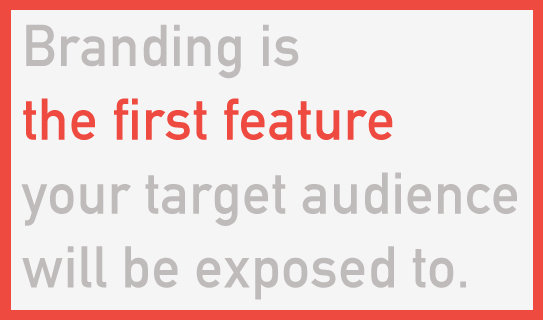
When you start a new venture, or initiate a new product offering, you tend to know best. You know your product best, you know your audience best, you know your marketplace best. You know your road map best. So, naturally, you are closing off quickly. Why? Because you know best.
Truth is, you just can’t be great at everything. I am not. No one is.
The moment you let go of that notion is the moment you open up to greatness. As a person, as a founder and as a brand.
Successful brands are built in collaboration with – and powered by insights from – specialists within their domain. The ones that are great at a certain thing, just like you are at your thing. It takes money and/or time, but for the ones who ‘get it,‘ like the one who wrote me above E-Mail, it will make for a better, if not great, brand.
This year be open, listen, absorb and analyze every step along the way as it relates to tasks like naming, brand identity, online presence, brand positioning, the same way you analyze, and more often than not over-analyze, each feature of your product or service offering. Branding is the first feature your target audience will be exposed to. It better click the right way, right away.
The Secret Behind Big Brands And How Entrepreneurs Can Learn From It
This was one of many topics I was asked about by a croatian startup site prior to the speech I gave two nights ago at the University of Zagreb for the Founder Institute. The interview was published in croatian, which you can peruse here if you speak the language (and want to analyze and help me understand why the Backstreet Boys invaded my Brand Atmosphere), but for the rest of you, here it is:
Startups, especially the ones you will be talking to in Zagreb, are mainly in their early stages. Do they even need branding in that stage? If they do – what kind of branding do they need?
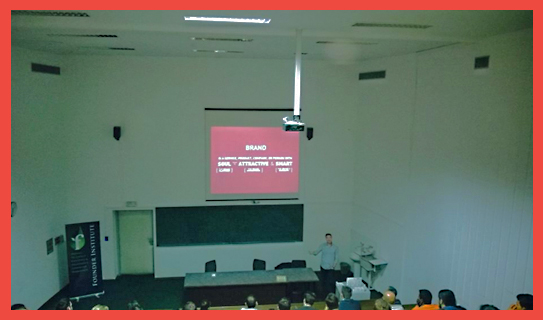
Fabian Geyrhalter speaking at the University of Zagreb for the Founder Institute, October 22, 2014
How can you brand yourself online when you are still a small startup, with a very small team and a limited budget?
When is the right time to hire someone (or a company) to help with branding?
Can you put together some sort of “emergency branding kit” for startups? What would that “kit” be made of?
It gets really difficult for a startup to choose their company name. It has to be unique, it has to be international, it needs to mean something. How do you achieve all of that and more with just one word?
How can a startup’s target audience help with forming a brand? What kind of feedback can that audience provide and how can a startup brand create an emotional connection with their potential customers?
What is the secret behind those huge, well known and beloved brands and what can small startups learn from them?
4 Crucial Steps You Need To Take Before Crafting Your New Venture’s Logo
Don’t hire us to create your logo. Not us, nor anyone else therefor. Sure, we could create a great logo for you. It would look timeless, be very well designed (I believe we are one of the best, and many agree), it would work across platforms and for years to come, and everybody would be telling you how much they love it. So why shouldn’t you hire us to create this important piece of branding for you?
Chances are you don’t need a logo designed. Not yet.
Chances are you need a brand built, and your logo is just a part of it. By creating a logo in a vacuum, and out of sync, you will likely fail. I don’t want you to fail. Nor be part of failure. I think we share this belief as entrepreneurs.
It’s the cart before the horse idiom: Why put the horse in place if we don’t know the message by the messenger yet?
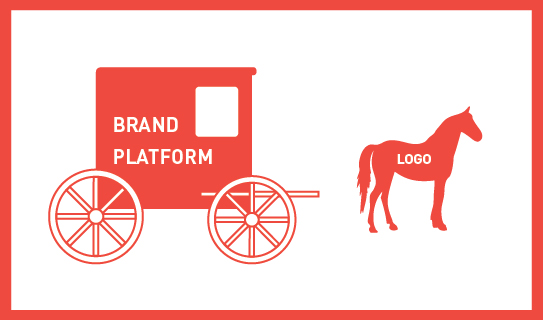
Below are 4 key elements you have to have in place prior to embarking on your logo design; they are the bare minimum requirements, the wheels of your cart so to speak:
1. You have a positioning statement in place that focuses on the ‘why’ and you stand tall behind it
2. You created 3 target audience personas that stand for who you are actually talking to/with
3. You know your brand personality and its associated keywords and are ready to act upon it
4. You have created a meaningful name that responds successfully to all of the above
If you don’t have these in place, creating a logo would be wasting your money, and (y)our time. It’s a lose-lose situation. How would any designer know what to design without these in place; how would the logo convey what it needed to convey; and finally, how could it connect with your audience? I don’t know, but I see it happen every day on the client’s expense.
Contact us if you need help getting there, as we love to assist and contribute, while speeding up that journey to your brand image.



